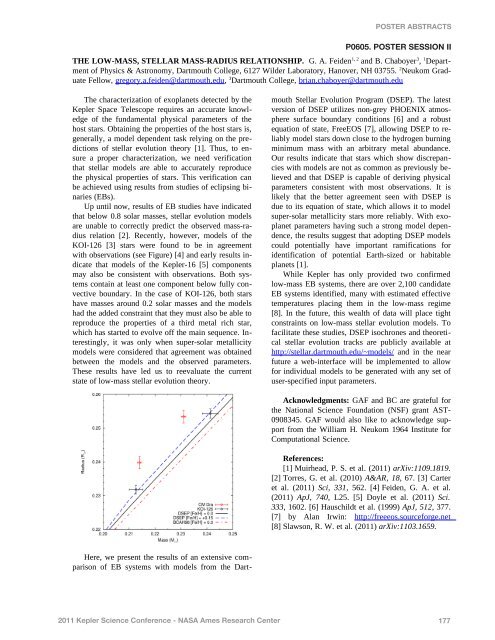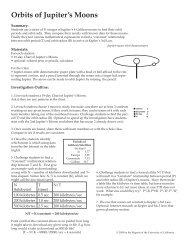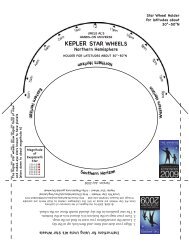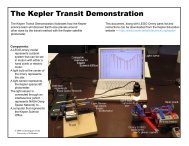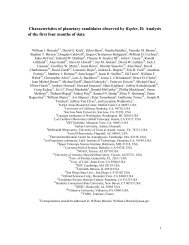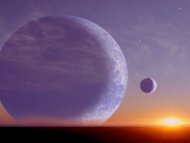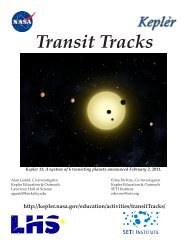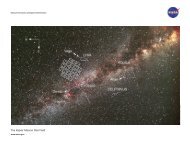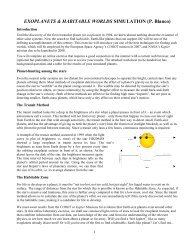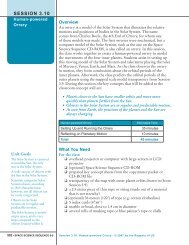Poster Abstracts - Kepler - NASA
Poster Abstracts - Kepler - NASA
Poster Abstracts - Kepler - NASA
- No tags were found...
You also want an ePaper? Increase the reach of your titles
YUMPU automatically turns print PDFs into web optimized ePapers that Google loves.
POSTER ABSTRACTSP0605. POSTER SESSION IITHE LOW-MASS, STELLAR MASS-RADIUS RELATIONSHIP. G. A. Feiden 1, 2 and B. Chaboyer 3 , 1 Departmentof Physics & Astronomy, Dartmouth College, 6127 Wilder Laboratory, Hanover, NH 03755. 2 Neukom GraduateFellow, gregory.a.feiden@dartmouth.edu, 3 Dartmouth College, brian.chaboyer@dartmouth.eduThe characterization of exoplanets detected by the<strong>Kepler</strong> Space Telescope requires an accurate knowledgeof the fundamental physical parameters of thehost stars. Obtaining the properties of the host stars is,generally, a model dependent task relying on the predictionsof stellar evolution theory [1]. Thus, to ensurea proper characterization, we need verificationthat stellar models are able to accurately reproducethe physical properties of stars. This verification canbe achieved using results from studies of eclipsing binaries(EBs).Up until now, results of EB studies have indicatedthat below 0.8 solar masses, stellar evolution modelsare unable to correctly predict the observed mass-radiusrelation [2]. Recently, however, models of theKOI-126 [3] stars were found to be in agreementwith observations (see Figure) [4] and early results indicatethat models of the <strong>Kepler</strong>-16 [5] componentsmay also be consistent with observations. Both systemscontain at least one component below fully convectiveboundary. In the case of KOI-126, both starshave masses around 0.2 solar masses and the modelshad the added constraint that they must also be able toreproduce the properties of a third metal rich star,which has started to evolve off the main sequence. Interestingly,it was only when super-solar metallicitymodels were considered that agreement was obtainedbetween the models and the observed parameters.These results have led us to reevaluate the currentstate of low-mass stellar evolution theory.Here, we present the results of an extensive comparisonof EB systems with models from the DartmouthStellar Evolution Program (DSEP). The latestversion of DSEP utilizes non-grey PHOENIX atmospheresurface boundary conditions [6] and a robustequation of state, FreeEOS [7], allowing DSEP to reliablymodel stars down close to the hydrogen burningminimum mass with an arbitrary metal abundance.Our results indicate that stars which show discrepancieswith models are not as common as previously believedand that DSEP is capable of deriving physicalparameters consistent with most observations. It islikely that the better agreement seen with DSEP isdue to its equation of state, which allows it to modelsuper-solar metallicity stars more reliably. With exoplanetparameters having such a strong model dependence,the results suggest that adopting DSEP modelscould potentially have important ramifications foridentification of potential Earth-sized or habitableplanets [1].While <strong>Kepler</strong> has only provided two confirmedlow-mass EB systems, there are over 2,100 candidateEB systems identified, many with estimated effectivetemperatures placing them in the low-mass regime[8]. In the future, this wealth of data will place tightconstraints on low-mass stellar evolution models. Tofacilitate these studies, DSEP isochrones and theoreticalstellar evolution tracks are publicly available athttp://stellar.dartmouth.edu/~models/ and in the nearfuture a web-interface will be implemented to allowfor individual models to be generated with any set ofuser-specified input parameters.Acknowledgments: GAF and BC are grateful forthe National Science Foundation (NSF) grant AST-0908345. GAF would also like to acknowledge supportfrom the William H. Neukom 1964 Institute forComputational Science.References:[1] Muirhead, P. S. et al. (2011) arXiv:1109.1819.[2] Torres, G. et al. (2010) A&AR, 18, 67. [3] Carteret al. (2011) Sci, 331, 562. [4] Feiden, G. A. et al.(2011) ApJ, 740, L25. [5] Doyle et al. (2011) Sci.333, 1602. [6] Hauschildt et al. (1999) ApJ, 512, 377.[7] by Alan Irwin: http://freeeos.sourceforge.net[8] Slawson, R. W. et al. (2011) arXiv:1103.1659.2011 <strong>Kepler</strong> Science Conference - <strong>NASA</strong> Ames Research Center 177


